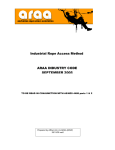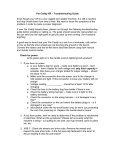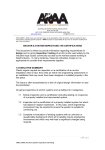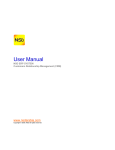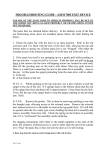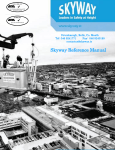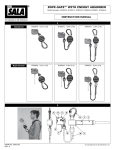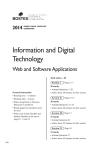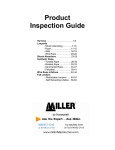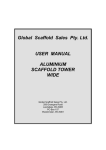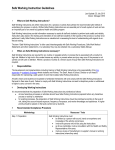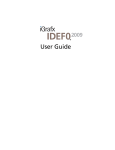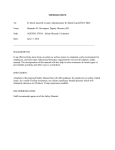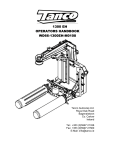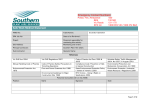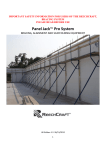Download - Australian Rope Access Association
Transcript
Industrial Rope Access Method ARAA INDUSTRY CODE SEPTEMBER 2005 TO BE READ IN CONJUNCTION WITH AS/NZS 4488 parts 1 & 2 Prepared by ARAA (Vic.) & ARAA (NSW) 8/9/05 ver1 Table of Contents Page Introduction Obligations System Parameters Application and Scope Definitions 3 4 4 5 5 Section 1 Selection Criteria Employers Duty Hazard Control Categories of Systems Selection Hierarchy 7 7 7 8 9 Section 2 Equipment & Installation Design requirements Structure and anchorage points Permanent system documentation In Case of Rescue Requirements Parapet integrity Auxiliary anchor layouts Equipment 10 10 11 13 13 13 15 Section 3 Use of Industrial Rope Access Systems Operational Requirements 18 Section 4 24 Conducting Hazard ID and Risk Assessments APPENDIX A. Work Method Statement, Hazard ID and Risk Assessment (suggested forms) B. C. D. Site Check list (suggested form) Operator Core Competencies NSW Addendum Tables Table 1 Table 2 Access System Categories Hierarchy of Risk Control 7 8 Note – this document is an update of the IRAA Industry Code 2000. The Association is in process of carrying out a comprehensive review of documentation pertaining to rope access use in industry and the following document is therefore put forward as a short term and relatively minor update whilst new documentation is drafted. For this reason especially, intending users should regularly visit the ARAA website (www.araa.net.au) to ensure they are working to the latest information available. The ARAA may be contacted via the web site or c/o the following addresses: Victoria – c/o 5/15 Tower Crt, Noble Park 3174, 03 97063979, fax 03 97063973 New South Wales – c/o THS, 10/87 Reserve Rd, Artarmon, 02 99669070, fax 02 99669071 ___________________________________________________________________________ ARAA Industry Code September 2005 Compiled by the ARAA (Vic) and ARAA (NSW) 2 DISCLAIMER This document has been prepared by the ARAA (Vic & NSW) with input from a wide representation of industry. It has been prepared to provide assistance to the rope access industry and those it serves, documenting current industry best practice. However due to the differences in local legislation, it should not be regarded as offering definitive legal advice. Users will need to check with the relevant regulations and to ensure compliance. No responsibility can be accepted for omissions or errors. Introduction The following document has been developed from the Safety Bulletin #27 jointly developed by IRAA (prior to name change to ARAA) and Victorian WorkCover. Users in NSW should ensure that the NSW Addendum at the rear of the document is read to establish if particular State based requirements exist. Users in other regions should also check with local Regulatory Authorities, and the ARAA web site to verify if other requirements are relevant to their operations. This document is the ARAA Industry Code for the Industrial Rope Access Technique. It forms the basis for self-regulation of the industry and is a practical guide for management, operators, building owners, architects and engineers who employ, design or specify Industrial Rope Access techniques for building façade or other work. It is proposed that State regulatory bodies responsible for OH&S legislation use this document to assist them in their regulatory role. The content of this document, drafted by the Australian Rope Access Association (Vic & NSW), is the culmination of extensive consultation with industrial rope access practitioners, building owners and managers, government bodies, relevant Australia/New Zealand Standards and other interested parties. This document should not be construed as covering all issues relevant to the industrial rope access system and further information may be found in the following documents: (1) (2) Australian/New Zealand Standards – in particular AS 4488.1 and AS 4488.2 WorkCover NSW Guidelines for Building Façade Access Systems, September 2000 The rope access industry is an evolving industry – the Association will, from time to time, find the need to review all or parts of this document. To ensure awareness of current requirements, operators and users are encouraged to regularly visit the ARAA web site www.araa.net.au to view updates, changes, alerts and the like. The Australian/New Zealand Standard for rope access is similarly subject to change and operators should ensure they are using the latest information available. ___________________________________________________________________________ ARAA Industry Code September 2005 Compiled by the ARAA (Vic) and ARAA (NSW) 3 OBLIGATIONS Under Occupational Health and Safety legislation in each of Australia’s States and Territories: • • • • Employers must provide and maintain equipment and systems of work that are safe and without risk to health. Employers must provide suitable supervision and training to enable works to be carried out safely. Employees must take care for the health and safety of themselves and fellow workers and co-operate with their employer whilst at work. Building owners must supply a safe means of access for repetitive works such as window cleaning. SYSTEM PARAMETERS Rope access is a manual system of providing access and which, by virtue of diversity of equipment and specialized use techniques, allows access to many different locations, such as: • • • • Suspended works on building facades, towers, bridges, and many other structures. Horizontal works such as under bridges, across roofs, etc. Lead climbing works where the operator moves beyond the last point of connection. Confined space works, recovery/access. The access method relies upon the use of the following: • • • An access system, which allows the operator to safely access the required area. This will often be a work rope, however on occasions, it may simply utilize elements of the structure (e.g. truss members of a tower or bridge), the roof of a building (assuming slope allows safe access – see AS/NZS 1891.4), or some other reliable form of access. This is an alternative where fall arrest systems in accordance with AS/NZS 1891 series are not a practical solution. A mandatory safety or backup rope/system, which acts as a fall protection system in the event of failure of the primary access system. This rope and associated hardware must be used in such a way as to minimize fall distance and to ensure a maximum load to the user or anchorage of 6kN in the event of a fall. Two points of connection must be maintained at all times. There must always be a physical connection to the backup or safety rope, and may also be a connection to the work rope, the structure etc. Rope access is used as either permanent systems, such as permanent façade access systems or temporarily in “one off” locations such as carrying out an inspection on a bridge or tower. Whilst this Industry Code generally addresses the permanent use of rope access, it is intended that the general principles apply to temporary uses and that the site controllers will exercise judgments to deal with the differences over issues such as marking of anchor points, documentation etc. ___________________________________________________________________________ ARAA Industry Code September 2005 Compiled by the ARAA (Vic) and ARAA (NSW) 4 Application and Scope This document covers the following areas: (1) (2) (3) (4) Selection of access systems. Equipment and Installation of industrial rope access systems. Use of industrial rope access systems. Hazard identification and risk management procedures. This document can be used to assist employers and practitioners comply with their responsibilities under the Regulations to identify hazards, assess their risks and control the risks associated with the installation and use of rope access equipment for industrial purposes. Definitions For the purposes of this document the following definitions apply: ACCESS ADVISOR - a person who has, through a combination of training, education and experience, acquired knowledge and skills within the access industry to enable advice to be given on the range of height access options ASSESSOR - a person endorsed by the ARAA to assess applicants for competency against the ARAA core competencies and to recommend the issue of an ARAA Certificate of Competency at the relevant level. BUILDING MANAGER/OWNER - means the individual or corporation that has the overall responsibility for the building or structure including its maintenance and upkeep, and includes a person or corporation authorised in writing by the Building Manager/Owner. ENGINEER - means a person eligible for corporate membership of the Institution of Engineers, Australia, and who is suitably qualified to assess the integrity of a building or structure and the anchorage points associated with the industrial rope access system. INDUSTRIAL ROPE ACCESS SYSTEM - an access system relying primarily on kernmantle ropes, which provide a backup system and may also, provide a kernmantle rope primary system. The system requires the use of a harness for the operator and may also use a swing chair for comfort. PARAPET - means any guardrail or wall on a roof, floor or structure designed or intended to prevent a person or object from falling from the roof, floor or structure. PROPRIETOR - means the owner, lessee or any individual or corporation having by whatever right or title the actual possession or control of the industrial rope access system. REASONABLE - means reasonable having regard to: (a) (b) the severity of the hazard or risk in question; the state of knowledge about that hazard or risk and any ways of removing or mitigating that hazard or risk; ___________________________________________________________________________ ARAA Industry Code September 2005 Compiled by the ARAA (Vic) and ARAA (NSW) 5 (c) (d) the availability and suitability of ways to remove or mitigate that hazard or risk; and the cost of removing or mitigating that hazard or risk. ROPE ACCESS OPERATOR - a person trained and assessed as competent to use an industrial rope access system. Level 1 - Basic - Able to operate, under supervision, on various systems. Level 2 - Basic Supervisor - Able design, setup and operate simple vertical systems. Level 3 - Advanced - Capable of designing, supervising and operating at all levels of involvement of these systems. ULTIMATE STRENGTH - Measurement of component strength, at which point it may have yielded, but at which it has not failed. I.e. it is still able to retain load. ___________________________________________________________________________ ARAA Industry Code September 2005 Compiled by the ARAA (Vic) and ARAA (NSW) 6 Section 1 Selection Criteria This section details the process whereby a building owner or manager is required to: a) b) c) d) assess the level of risk in a particular job according to Table 2; conduct a Hazard ID and Risk Assessment (see Section 4); select an access system according to Table 1; determining when submissions to State regulatory bodies responsible for OH&S legislation are required – this is on a State specific basis – see Addendum(s) at rear for each State affected. 1.1 Employers duty to undertake control of risk In order to establish the safe work practice required for the access system, the building manager and the proprietor should consider the following: 1.1.1 Hazard Control Conducting Hazard Identifications and Risk Assessments In order to meet their responsibilities under OH&S legislation, employers must identify and rate hazards in a workplace. The employer should then establish the appropriate level of control of risks, and then select the most suitable access system. To achieve this, the building owner/manager should conduct a formal hazard identification and risk assessment of the job. This may be done with the assistance of a competent access advisor. To assist the building manager, often the access advisor will conduct the assessment on their behalf and then obtain agreement or approval from the building manager prior to proceeding. In carrying out the assessment, attention should be given not only to the levels of risk in carrying out the works, but also in setting up, commissioning, maintaining and when required, stripping out the access equipment. ___________________________________________________________________________ ARAA Industry Code September 2005 Compiled by the ARAA (Vic) and ARAA (NSW) 7 1.2 Categories of Systems Table 1. Access Systems Categories Category System Description Passive forms Access from fixed or portable structures where the use of anti-fall devices is not required. This is preferable as there is little need for supervision, training, on-going servicing etc. Active forms Systems that use purpose built personnel lifting/lowering appliances as means of access. This area requires supervision, training, servicing and in some cases, may require operator agility and fitness to function correctly. PPE or administrative controls Those systems that rely primarily on the use of personal protective equipment (PPE) such as fall restraints and/or administrative controls such as training, supervision and operator skills. Practices/Techniques • • • • • • • • • • • • Firm surfaces such as room floors, balconies and streets. Permanent installed fixed platforms and access equipment. Inside, via opening windows, the size and configuration of which protects the person from falling out. Permanently installed building maintenance units (BMUs). Scaffolds. Mast climbing work platforms. Elevating work platforms. Temporary installed swing stages. Industrial Rope Access systems. Portable ladders**. Access from unprotected ledges of buildings with fall protection systems. Access from open-able windows where fall protection systems are required. ** Note that the Victorian Falls Regulations, 2004, rate portable ladders at a very low level and often as a method of “last resort”. They are left under “active forms” as they are an active form of access/protection but users should not therefore think they are “acceptable”. The ARAA advises use of portable ladders sparingly, and when used, if it is practical, additional methods of fall protection should be considered. ___________________________________________________________________________ ARAA Industry Code September 2005 Compiled by the ARAA (Vic) and ARAA (NSW) 8 1.2.1 Selection Hierarchy Once the building manager is aware of the types of access systems available (set out in Table above); the following hierarchy should be followed in order to establish the most suitable access system for the particular job. Table 2. Hierarchy of Risk Control - Access System Decision Level 1. 2. 3. Control Decision Elimination of the risks whenever reasonable. Minimization of the risks if it is not reasonable to eliminate them. If elimination or minimization by levels one and two are not practical. Description Consideration This is the highest level in the hierarchy of control and where reasonable, is the preferred option. E.g. Improved building design considering permanent access requirements. In the case of access systems this should be primarily effected through a focus on, • Substitution of the access system with a less hazardous system. • Modification of the design of the plant. • Isolation of the hazard and/or • Engineering controls. If risks are still not minimized then the use of appropriate personal protective equipment (PPE) must be used. This is the second level control and should be adopted if elimination of the risks is not reasonable. E.g. Use suspended access in lieu of long ladders. E.g. Install permanent anchors in lieu of temporary anchors. E.g. Restricted work area. The use of PPE or administrative controls is deemed to represent the lowest level of controlling the risks. They should only be used as a last consideration or as a supplement to the above controls. E g. Fall protection systems complying with AS/NZS 1891 series. Systems in this category should be used when options in levels 1. and 2. are exhausted. Portable ladders ___________________________________________________________________________ ARAA Industry Code September 2005 Compiled by the ARAA (Vic) and ARAA (NSW) 9 Section 2 Equipment and Installation of Industrial Rope Access systems This section details important aspects of: 1. 2. Design requirements for equipment and installation of industrial rope access systems. Points to note re safe use of industrial rope access systems. Further information is provided in Australian Standard AS/NZS 4488 Parts 1 & 2 which should be read in conjunction with this section. Note that these requirements are directed primarily at permanent works, however on temporary installations, the employer and site controller shall take account of these requirements in the work method statement and risk assessment. 2.1 Design Requirements 2.1.1 Structure and Anchorage Points Where the suspension ropes or safety ropes are attached to an existing structure which is part of the building, structure or a temporarily erected structure. a. The anchorage points and the building structure must be capable of withstanding an ultimate load in the attached suspension and safety ropes of at least 12kN in the direction(s) of loading in use (equivalent to suspending approximately 1200Kg). (Note, the ARAA advises design for 15 kN ult. as preferable so that anchors can also be used for fall protection – this eliminates potential confusion) b. The building or structure and anchorage points should be assessed by an engineer, unless it is clear to a competent person that the anchorage system is structurally adequate. In either case, the person making the assessment shall document this. An example of where an engineer may not be required is where an anchorage sling, of the correct capacity, is secured around a solid, permanent structure such as a plant room, major structural members, suitable bracing members in bridges/towers etc. However, if any doubt as to the structural adequacy of the anchorage exists, an engineer should be involved. Dynamic loads with rope access equipment can be considerably higher than the static loads. The engineer shall certify in writing that all combinations of loads in a worst-case situation could be safely contained by the proposed structure and anchorage points. c. A copy of the documentation shall be kept on site while the system is being used. This documentation may also include such documents as Work Method Statements, risk assessments, rigging plan, site checklists, insurance details, MSDS sheets, contact numbers for emergency services , service/inspection requirements etc. d. Prior to first use and annually, a competent person shall inspect and certify in writing that the structure and anchorage points correspond with the drawings provided and that the effects of corrosion or any other factors have ___________________________________________________________________________ 10 ARAA Industry Code September 2005 Compiled by the ARAA (Vic) and ARAA (NSW) not rendered the structure or anchorage points unsafe for use with the industrial rope access equipment. e. Where anchors are to be exposed to weather and/or are used for extended periods, the manufacturer should state that the anchors are suitable for such applications. Holes should be suitably sealed to prevent ingress of moisture. ANCHOR PLACEMENT Where anchors are installed permanently on buildings their placement should be such that the user can connect to the system in safety. In most cases this means the anchor system should be installed at least 2m away from fall hazards. However in some cases, this may also require the use of supplementary fall protection methods to ensure the risk of falling is removed or minimized. 2.1.2 Permanent System Documentation. Any permanent rope access anchor system, (intended to be left in place for permanent use) following installation, shall be supplied with documentation that is kept on site by building management and shall be made available to any rope access crew prior to works proceeding. This documentation should include at least the following information: • Installing person/company, date of installation and full written instructions to enable anchor system to be understood by a competent rope access operator • An initial risk assessment • Any details required to indicate servicing and maintenance requirements for the installation • Testing information, if any, relevant to the installation • Contact details to the installing person/company and any additional Engineering body • Plan of area of anchors (generally a roof plan) and to include rigging plan for all drops/anchors • Location of all anchor points with marking to show intended use (ie. Main anchor, diversion etc) and intended direction of loading • A statement setting out the purpose of the designer in choosing anchor locations – ie. Are they for general façade access, window cleaning only, gutter cleaning etc. • Definition of whether anchor is within the zone of 2m from an edge or potential fall zone • If anchors are placed on façade or vertical surface of structure for purposes of re-anchor (re-belay), diversion, deviation or lateral stability, an elevation should be shown for each face with location and purpose of each anchor shown. • Where the users are required to supply/use additional equipment such as slings, the details of this requirement should be set out to clearly define what length, rating, configuration etc is required. Additionally, if such rigging requires the use of a Rigging qualification, this should be noted. • Requirements for public protection in conjunction with the works – in some cases this may require drawings and on occasions, special equipment, permits etc. • Requirements for any special protection needing to be placed or supplied by he operatives, to protect the building, the equipment and the operators. • Details of any special requirements that are unusual for a competent rope access team. • Anticipated rescue plan and any special details, equipment or skills that are expected of the team in relation to this plan • The minimum Supervisor level required for the works and where relevant, the minimum team size required to carry out anticipated works (note, works may later arise that utilise the anchor system in a manner that differs from that specified in the user manual – in such cases, it is the responsibility of the Supervisor to document these differences and to assess the system’s capacity to deal with these new circumstances) ___________________________________________________________________________ 11 ARAA Industry Code September 2005 Compiled by the ARAA (Vic) and ARAA (NSW) All permanent anchor points should be marked with the following information. This should, where practical, be fixed to or at, each anchor but may, in some cases be fitted at one location such as the access door to a roof. A case where it is understood that individual anchors may not be able to be individually marked, is those on a façade where they may cause aesthetic issues. Irrespective of this, all anchors should be marked with at least a serial No or batch No to enable traceability of individual anchors. Marking should include: • Manufacturer’s contact • Installer’s contact • Load rating • Specific use if not also suited as a fall protection anchor. • Most recent inspection/service date Following any incident such as a fall, affected anchors should be tagged and withdrawn from service until engineering assessment/inspection has been carried out by a competent person and the anchor replaced/repaired or re-certified. The documentation supplied for use on site by the installation person/company should be signed by an individual of that body as the person taking responsibility for the proper design, specification and installation of the works. 2.1.2 Purpose Built Suspension Rigs Where the suspension ropes or safety ropes are attached to a purpose built suspension rig specifically designed for industrial rope access systems, the following applies: a. The purpose built suspension rig should be clearly and permanently marked with its brand name, model number, and serial number so as to ensure trace-ability. The purpose built suspension rig should also be clearly and permanently marked with its capacity and intended use (for example "Capacity - one person plus 8 kg of equipment using industrial rope access method"). Any movable or removable counterweights should be clearly marked with their mass in kilograms. b. Erection and operating instructions should accompany every purpose built suspension rig and should be easily understood. Where any additional equipment is specified, there should be clear instructions for the use of such equipment on the purpose built suspension rig. Where counterweights are of the removable type, instructions should clearly state the total weight of the counterweights required, and where such counterweights are to be positioned for a given application. c. The purpose built suspension rig design should be verified by an engineer. The design should take into account the most adverse combination of loads but should in any case be designed for not less than 12 kN ultimate strength. d. Prior to use it should be ensured that the building or structure supporting the purpose built suspension rig is adequate for the most adverse combination of loads transmitted from the industrial rope access system. ___________________________________________________________________________ 12 ARAA Industry Code September 2005 Compiled by the ARAA (Vic) and ARAA (NSW) PLEASE NOTE THE FOLLOWING If the counterweighted needle is a “proprietary” item, designed and configured for rope access use and suitably covered by instructions and labeling and if the users have been suitably trained, then a Rigging qualification is not required to erect the needle (it MAY still be required for the under frame if this is not “proprietary”). In any other case, a Rigging qualification is required. If further clarification is required contact ARAA or WorkCover Victoria or NSW. RESCUE REQUIREMENTS The use of a counterweighted structure means there is a finite factor of safety on stability. As a result, users are cautioned with regards to use of this equipment for any contact rescue. Wherever possible, when using counterweighted anchors (this applies for normal anchors also, but is not always as critical) a non contact rescue is preferable (eg. Lowering to ground or raising without need for second person to be “on rope”), however this must be weighed up with the possibility of longer rescue times. If a second person intends to use the same counterweighted anchor for a potential rescue then the risk assessment should investigate the possible need for additional counterweights and should ensure the structure is adequately strong for this purpose. The Association plans, in due course, to address the issue of anchor use for possible rescues and this information will be released as an addendum to this document or in a separate document. In the meantime users are cautioned to consider this issue when setting up rope access anchorages including counterweighted units. 2.1.3 Parapet Integrity Any load bearing parapet becomes part of the suspension system and should be treated as in clause 2.1.1(a)&(b). Some parapets may appear to be structurally solid but may only be of cosmetic value. One example of this is where polystyrene parapets have been clad and painted to resemble reinforced concrete. The assessment of the integrity of the parapet shall be documented by an engineer or competent person. 2.1.4 Auxiliary Anchor Layouts The following section gives some guidance on the use anchors other than main anchors which may be incorporated in a system. DEVIATIONS. A deviation is the use of an anchor to change the line of a rope access drop. We use them for roof rigging where they are generally termed a “diversion”. When used in the vertical plane, they are generally referred to as “deviations”. Clarification needs to be given to the “deviation” issue for 2 reasons: • 1/ To ensure proper rigging as improper rigging can lead to very high loads. • 2/ Depending upon whether the “20 degree rule” (see below) is exceeded or not MAY define whether a site needs to be supervised by a Level 2 or Level 3 operator. Typically, a deviation is used to either change the straight line “drop” of a rope in order to avoid some obstacle on the building such as a balcony or pipe, but is also often used to “pull in” the ropes under an overhang. ___________________________________________________________________________ 13 ARAA Industry Code September 2005 Compiled by the ARAA (Vic) and ARAA (NSW) A Level 2 operator may supervise a city building site where it is possible to carry out a rescue by taking the disabled operator straight down to the ground or a lower level. Under these conditions, the IRAA has decreed that the rope may be deviated up to a maximum of 20 degrees and still be considered to fall within a Level 2 supervision. Legend: A B C D E F G H I Engineered primary anchor Counterweighted anchor Diversion anchor Re-Anchor (re-belay) Deviation Lateral restraint Primary anchor – existing structure – (improvised anchor) Aid anchor (aid route) Edge protection If the 20 degree deviation is exceeded, then a more complex rescue (and risk assessment etc) is likely and therefore, a Level 3 must run the site. The above needs to be taken into account in both the system design, documentation, equipment structure and crew makeup. The ARAA recommends a minimum design load for a deviation of 6kN ult. It must be remembered that apart from the loadings imposed by an operator, the anchor may need to also function during a rescue. ___________________________________________________________________________ 14 ARAA Industry Code September 2005 Compiled by the ARAA (Vic) and ARAA (NSW) DIVERSION The term “diversion” is generally used for any diverting of the primary and backup ropes in the horizontal plane – ie. Before the operator goes over the edge. Structurally, there is no difference to a deviation, however there are not the same implications in relation to rescue. The included angle between the ropes being diverted and the line back to the diversion anchor must NEVER exceed 120 degrees and should be kept to a maximum of 90 degrees wherever possible. Operators need to be mindful that both the work/backup ropes and the diversion ropes need to be free to take their load back to the anchor (ie. Not hooked on some part of the structure which inadvertently becomes an anchor) and in addition, provision must be made to ensure the diversion rope and connection to the work/backup ropes cannot flick over the edge at which point it can cause a pendulum to the operator and at the very least, will run along a potentially sharp edge of the building. Various rigging practices are used to avoid this effect – speak with your trainer/assessor or contact any of the ARAA Committee to discuss. RE-ANCHOR (RE-BELAY) If we take the ropes back in under an overhang sharply, this becomes a new anchor and is commonly termed a re-belay (this also gets over the difficult issue of rope protection at edge of overhang). This effectively becomes a new primary anchor and as such, this anchor must meet the same loading criteria as a primary anchor. In this situation, a Level 3 would also need to run the site due to the complications of initial rigging and rescue. Note there are issues here in relation to whether the safety rope as well as the work rope is re-anchored. This is covered by the need to minimize fall distance and must be treated on a case by case basis. The Association intends to develop documentation at a later stage in relation to this issue. Further, the potential issue of drilled in anchors used in tension (pull out) need to be considered in this style of anchor. LATERAL RESTRAINT A lateral restraint is used to stabilize the operator against the forces of wind when the operator is working on a long drop. Window cleaners often carry suckers to use locally so that when they are cleaning a particular set of windows, the sucker (on a lanyard!) can be fixed to the window so they can use their weight without pushing away from the building. On a very tall building, where wind may be an issue, the rope access worker has 2 options ;work only when it’s not windy, or install some form of lateral restraint to minimize the effects of wind. Of course, if it’s too windy to work safely, the work should be stopped by the supervisor. The ARAA recommends the fitting of lateral restraints on permanent installations at approx. 50m cts vertically. This is generally only necessary on buildings in excess of 50m high, unless the building has a known problem with winds, generally because of the effects of adjacent buildings. The lateral restraints are generally installed in the centre of each drop so that horizontally, around 3m cts is appropriate for full glazing. The design should allow easy fixing of the ropes and should allow the ropes to be drawn through the fixing from the top. A pigtail design is often used for this. The loadings on the lateral restraints is not high, we suggest a minimum of 50 kg, in an outwards or lateral direction as a minimum design load. 2.2. Equipment ___________________________________________________________________________ 15 ARAA Industry Code September 2005 Compiled by the ARAA (Vic) and ARAA (NSW) Equipment specification issues are covered in AS/NZS 4488.1. Selection and safe use issues are covered in AS/NZS 4488.2. 2.2.1 . General Comments All equipment that may be used either regularly or from time to time as suspension or safety / restraint must be indelibly marked and logged, in such a way as to be easily traceable to the manufacturers batch details. Some form of record must be kept on site as well as in a companies office so that recall of any piece of equipment may be achieved promptly. Suspension equipment should be inspected by a competent person at periods not exceeding 6 months. (This is not inclusive of the tactile examination of each item, prior to it's use.) The records of these inspections should be kept up to date, and include such details as where the equipment was used, it's storage conditions, and involvement in potentially damaging incidents. Any damaged or faulty equipment must be isolated immediately it is identified, and not returned to service until it has been appropriately repaired. Equipment which has been removed from service permanently due to age or damage must be rendered unusable, and disposed of in such a manner that it cannot be returned to service. 2.2.2 Ropes The following may be considered in addition to AS 4488 Static ropes may also conform to EN 1891. Ropes or sections thereof used for 'dynamic' lanyards or 'lead climbing' must conform to EN 892, and also be a minimum 10.5mm. Ideally models designed for heavy duty use should be selected for this purpose, consult the retailers or manufacturer. All ropes should be inspected before each use. Any rope that has sheath damage and/or reveals its kernel through the sheath should be removed from use as either a working rope or safety rope. Rope should be protected against any possible damage, including damage from abrasion, incision or excessive heat. 2.2.3 Slings for anchorage purposes. Slings used for anchoring to parts of a building or structure should have substantially greater strength than the 12 kN general requirement, as this is an area with high potential for accidental and unseen damage and tampering. A safety factor of 5:1 will allow for accidental poor rigging practice. Lifting/cranage type slings, either Flexible Steel Wire Rope or synthetic round or flat slings, are ideal for this purpose. Care should be taken when arranging such slings so as not to overfill the carabiner connection to the rope. It is prudent to use similarly rated shackles for the sling to rope ___________________________________________________________________________ 16 ARAA Industry Code September 2005 Compiled by the ARAA (Vic) and ARAA (NSW) connection. (Ref to 'A Guide to Dogging' Victorian Workcover Authority for correct slinging methods and calculations.) If using carabiners for attachment of ropes to slings a choke hitch is the recommended sling configuration. Basket hitches may introduce multiple load angles to the carabiner, which is undesirable. 2.2.4 Helmets Helmets should be worn by all operators involved in suspended works, and where other safe work practices would necessitate (eg groundsperson, fall protection.) Helmets should comply with AS 1801 or EN 12492, and should be fitted with a Y shaped harness where a strap passes both in front and behind the ear. This type of harness properly adjusted will retain the helmet even when the user is inverted. Models are now available with face shields and ear muff sockets, as well as headlamp securing cords and clips. ___________________________________________________________________________ 17 ARAA Industry Code September 2005 Compiled by the ARAA (Vic) and ARAA (NSW) Section 3 Use of industrial rope access systems 3.1 Operational Requirements This section details • Requirements for the use of industrial rope access systems. CONNECTION POINTS (general comments) AT THE OPERATOR The operator connects to the ropes or the structure via 2 ropes or devices. The connection of these to the harness should be separate (by knot, karabiner, maillon etc) but may connect to one defined connection point on the harness – usually a sewn loop or metal attachment specifically provided by the manufacturer for this purpose. The theory is that this point on the harness is an engineered, tested point and as such, may be regarded as a safe point. AT THE ANCHOR The 2 ropes should connect separately to an anchor or anchors, which should be placed as closely as possible together (this is to ensure that in the event of a failure, the resultant fall will be short and without pendulum). This is generally by karabiner or knot. Most operators also back each of these points up to each other. This is not a requirement, but a sensible precaution that is good practice. The anchor may be one device if: • It is an engineered device designed for connection of 2 ropes to it, or • It is a structural element that is clearly strong enough to support both ropes. For example, this may be a large column or beam or a building element such as a plant room. INDEPENDENT CONNECTION The lines should be independently connected to the anchor point and the user. In both cases, the load eventually returns to one point, either the structure or the user. While it cannot be set out definitively, as each case differs, the following information will assist the specifier or user to understand what “independent connection” means. 1/ IN THE CASE OF THE ANCHOR POINT Part of the training of rope access operators, and in particular, supervisors, is to provide the skill to make judgments on adequacy of anchor points. If an anchor is being made to a lightweight item or a geographical feature which cannot be assured of performance, it is suggested that: • The ropes are connected to the structure or item completely independently. This would be typically, via 2 slings around a (say) tree. • Where performance cannot be guaranteed, the connections should be backed up, wherever possible, to another anchor or feature as a safeguard. • Where many anchors are possible at one point, consideration should be given to either anchoring the lines to separate anchors and backing up to each other or rigging a load sharing anchor which shares the load amongst numerous anchors to ensure that no one anchor point failure would be catastrophic. If an anchor is being made to an engineered structure where experience and knowledge of the operator ensures that the anchor has more than adequate capacity: • It is still advised, where possible, to anchor separately, via slings or separate connection devices. • Where defined anchor points are installed, such as a permanent installation, the installing company should provide separate connection points or holes even if in the one plate, so that operators can connect karabiners to defined locations. ___________________________________________________________________________ 18 ARAA Industry Code September 2005 Compiled by the ARAA (Vic) and ARAA (NSW) • Where an engineered item, such as a counterweighted needle, is designed it may be acceptable for the loads to terminate at this one device, the designer should provide 2 independent points of connection so that operators have little confusion over appropriate connection points. 2/ IN THE CASE OF THE USER A single connection point (such as a loop or ring) may be acceptable if the manufacturer has defined this as such on the harness design and user instructions. Otherwise, a harness should be selected with 2 separate points of connection for the work and safety ropes. It is expected that an operator would wear a single harness. The following points should be noted regarding the use of industrial rope access systems, 3.1.1 Attachment Prior to Suspension In vertical scenarios any person using industrial rope access equipment should be attached to both the working rope and the safety rope prior to moving off the roof or landing or climbing over the parapet. In other types of works a separate work positioning and backup attachment must be maintained in exposed locations. The backup should always be the first connection made and the last to be disconnected. 3.1.2 Suspension Point Height Effective lateral restraints should be used to provide stability where appropriate, particularly on tall buildings. (A “rule of thumb” for consideration of restraints is 50m, however they may be required well before this height on some buildings). 3.1.3 Windy conditions The industrial rope access system (like many other access systems) should not be used in high winds - this is a factor to be considered, particularly on taller structures, when carrying out the Hazard Id and Risk Assessment. On many sites, a change in location from one face to another may allow works to proceed, even in periods of high or gusty winds. 3.1.3 Rescue The industrial rope access system should not be installed in any location where it is not possible to provide prompt assistance or rescue if required. Prior to setting up of the system a rescue plan should be developed. Such a plan should consider the following factors: ♦ guidance from rescue agencies. ♦ type and availability of rescue equipment. ♦ foreseeable types of injuries and ailments. ♦ first aid experience of personnel on site. ♦ emergency services and associated plant (e.g. travel towers) available. ♦ possible need for a dedicated, pre-set up rescue system to be in place. ___________________________________________________________________________ 19 ARAA Industry Code September 2005 Compiled by the ARAA (Vic) and ARAA (NSW) 3.1.4 Surface Area and Weight Industrial rope access equipment should not be used for work that requires the operator to handle objects and materials of excessive size or weight or that may be difficult to handle due to wind loading. Where the largest side of an object has an area greater than 0.25m2 and/or the object is heavier than 8 kg, methods to eliminate unacceptable risk should form part of the hazard identification and risk assessment and such methods should be utilized. Refer to Hazard ID and Risk Assessment in Section 4. Items greater than these dimensions must be independently suspended by the holder of an appropriate rigging certificate. (Ref to 'A Guide to Dogging' Victorian Workcover Authority for correct slinging methods, calculations and certification requirements.) Not withstanding the above, all objects and materials should be secured by lanyard to the operator, or swing seat, or to a separate rope to effectively prevent from falling. 3.1.5 Electrical Hazards Industrial rope access systems should not be used where the user can receive electric shock from exposed live electrical conductors. In the absence of specialized measures, the system is generally not considered suitable for carrying out work on live electrical equipment due to the difficulty in providing immediate first aid and rescue in the event of electric shock. Where live electrical work must be performed Level 3 supervision must be provided. All high voltage (>36V) appliances used during suspended works should be protected with a residual current device. All appliances and their leads should be inspected and tagged by an A grade electrician at no greater than quarterly intervals, in accordance with construction site protocols. 3.1.6 Corrosive Environments Industrial rope access equipment should not be used in any environment, or with any substance that will cause the equipment to suffer undue or excessive corrosion, or damage the integrity of the equipment. 3.1.7 Public Protection When the industrial rope access system is used over an area open to traffic, either vehicle or pedestrian, at least one of the following should be provided: (a) Barricades around the area to prevent access. The barricades should have warning signs indicating that a person is working overhead and should generally be continuous and adequate, having regard to the location and pedestrian and vehicle traffic needs. (b) Overhead catch platforms above the area, designed to support a live load not less than a uniformly distributed load of 5 kPa. Some local authorities require that, when provided, overhead cover ways be designed to support at ___________________________________________________________________________ 20 ARAA Industry Code September 2005 Compiled by the ARAA (Vic) and ARAA (NSW) least 10 kPa. The ARAA recommends that users check with local authorities before works commence. (c) 3.1.8 For short duration work in low traffic areas only where the above are not practicable; an observer or sentry, situated at street level, to control public movement, with appropriate signs provided. The Use of Tool Lanyards. As a general rule all tools and equipment should be secured from dropping during rope access activities. This is best achieved by attaching a security lanyard between the worker and object, and carrying the object in a suitable bag or container. Individual tools and objects covered by this guideline must not be greater that 8kg or 0.25 ms on any surface. (See 3.1.4) Should this be here? The total weight of tools or equipment carried is dependant on the capacity of the It is important for all to suspension system (descender, back up device etc.) A safety factor of 10:1 should be be aware of, could it move to somewhere in maintained regarding the workers ropes and attachment hardware. The used of tool lanyards does not eliminate the need for suitable overhead protection or section 2 concerned exclusion zones below work areas. with the system. Electric tools must never be secured or suspended by their power cord. When selecting suitable materials for use as lanyards, tool type, duration of use and likely rate of wear must be considered. For example a stainless steel lanyard may be suitable for hand tools used near sharp edges, however not appropriate to use on a 240V power tool, as the wire could abrade the casing or lead. Kernmantle nylon cord can be excellent material as it has some shock absorption capacity, and any substantial cut damage is easy to determine, as the load carrying core is commonly a different colour to the sheath. The lanyard selected should have a retained safety factor of at least 10:1 after termination (by swage, knot, splice or other appropriate method). Only materials with a known minimum breaking strength should be used. Lanyards should be attached so as not to damage the structure of the tool or object. If it is not possible to attach through a hole in the item, a rolling or multiple clove hitch suitably bound to stop loosening may suffice. Lanyards of any material should not be placed through sharp edged holes, a shackle or similar should be used. Lanyards should be inspected prior to use each day. An inspection at no greater than 3 month intervals should be performed by a competent person. This 3 month inspection could coincide with electrical tool ‘tagging’. The longer term (ie 3 month or greater) lanyards should be marked with a unique identification for quality assurance purposes. Inspection methods for wear and damage identical to those carried out on the access system components. Bags and containers for suspension of gear should have a retained safety factor of 5:1 relative to the expected loads, and inspected as part of the same system. Some operations such as handling screws, or nuts and bolts have no reasonable means of containing loose parts. Suitable work methods should be developed so that these tasks can be performed in a comfortable position to reduce the chance of dropping. Clearly, such items should be carried in substantial bags with a method of closing. ___________________________________________________________________________ 21 ARAA Industry Code September 2005 Compiled by the ARAA (Vic) and ARAA (NSW) 3.1.10 Operator Competence (See note re transition arrangements, below) Personnel setting up and using industrial rope access systems should be adequately trained and be able to demonstrate their level of competence and should work in teams as set out below. Documentation detailing the satisfactory assessment of competence, such as an ARAA certificate, either at the conclusion of a training course by an independent assessor or as a stand alone assessment is the usual method of demonstrating competency. For a list of ARAA assessors log on to www.araa.net.au The ARAA competencies are formed in a three level system as detailed below. Note: Appendix D outlines these competencies in detail. Level 1 – Basic Operator. The Level 1 has the skills to safely work within a variety of safety systems employed in Industrial Rope Access under the direct supervision of a Level 2 or Level 3 supervisors. Level 2 – Basic Supervisor. An intermediate qualification incorporating the skills required to safely employ and supervise rope access activities for vertical only works in an urban environment, and to work in a supporting role to Level 3 supervisors on complex work sites. *N.B. "Vertical only" works can be those defined as sites where it is possible to lower an injured worker directly to the ground or a suitable landing, and where diversion anchors (creating a maximum deflection of 20deg) are used along the fall of the rope. No knots or reanchoring points may be employed along the falls of rope. ie simple retrieval methods are adequate. Level 3 – Advanced Supervisor Advanced qualification that is required for a team leader where complex works such as traverses, lead climbing, work over water, confined spaces are required. Will have more experience in rescue planning and in documentation of works. Note that sites where numerous other trades and operating plant and equipment are present (building sites, refineries, power stations etc) are automatically a complex site and require a Level 3 Supervisor. 3.1.12 Incident Management An effective incident management plan shall be in place prior to works proceeding. 3.1.13 Team makeup Teams should be chosen according to the risk assessment performed on site. The team makeup should be determined by the supervisor based on: • • • • Hazard ID & Risk Assessment. Complexity of the task. Experience of the operators. Experience of the supervisor. ___________________________________________________________________________ 22 ARAA Industry Code September 2005 Compiled by the ARAA (Vic) and ARAA (NSW) • Rescue capability. Depending upon the nature of the works, the make up of the team will have differing requirements. Only if team compositions create sufficient strength of skills can works be justified within a task/job safety analysis. Consideration should be given to adequate supervision, communication, rescue, remoteness, etc. The following minimum provisions apply: No person may work using Industrial Rope Access methods alone or isolated from other members of a team. The only exception here is where direct and constant verbal communication can be maintained. This contact may be made by radio, but not mobile phone. Any loss of communication in such a case would initiate investigation and/or retrieval. Examples of this situation would be confined space works. A rope access team must comprise of a minimum 2 certificated people, one of whom must hold a minimum Level 2 cert. On vertical urban (basic) sites a Level 2 certificate holder must directly supervise no more than 3 x Level 1 certificate holders. On complex sites where vertical only works are employed (as described above) a Level x 3 must be present at all times and may have 2 "Basic" teams working in clear verbal contact. For sites involving potentially difficult retrievals, eg confined spaces, works over water, and horizontal movement, the minimum team requirement is for a Level 3 accompanied by 1 x Level 2 and 1x Level 1. In the case of confined spaces works; Where Industrial Rope Access techniques are used, all members of the team must hold relevant certificates of competency for confined space entry. Careful consideration must be given to entanglement issues if breathing apparatus is to be used. Self contained escape sets must be carried by all persons entering the space. A Level 3 supervisor must remain outside the space, as the observer in charge of the retrieval systems. The anchorage/suspension systems used must provide a minimum of 1.8mtrs of clear head room, so as to remove a potential casualty completely from the space. Where companies employ specially developed methods for their core business activities, eg confined space entry, the use of a Level 3 may not be required. Such companies would be expected to have their participating workers fully trained in such internally developed methods, with clearly documented task outlines and emergency procedures. The training of these workers should be documented. Similarly the bulk of vertical urban works involving facade cleaning and maintenance is unlikely to require the supervision of a Level 3. 3.1.14 Stopper knots All ropes should be fitted with stopper knots or set up such that it is not possible for the user to inadvertently come off the end of the rope with work or backup equipment. ___________________________________________________________________________ 23 ARAA Industry Code September 2005 Compiled by the ARAA (Vic) and ARAA (NSW) 3.1.15 Suspension trauma The issue of suspension trauma is a recently recognized phenomenon that raises issues for any operator that may need to be suspended in a harness, chair, stretcher etc. and as such is not restricted to only rope access works. This issue is still being investigated and therefore no definitive “rules” may be applied, however some general information is available. Whilst this issue cannot be adequately covered in this document, operators are advised to seek further information* on the issue and to take this into account in planning both works and rescue. What can be generalized is that there currently appears to be major advantages in the affected user being in a position where: A/ he/she can use feet/legs against a surface to promote return blood flow. B/ be in a position, e.g. on a swing seat, where comfort can be adjusted periodically. C/ be in a position where the user or an aide can move the affected person into a horizontal or even head down location to promote return blood from the legs. D/ be in a position whereby the affected person can be swiftly removed from suspension and returned to ground level. Rope access, with its use of front attachment harnesses, swing chairs and team training and composition ensures the above requirements can be met. It is becoming apparent that the handling of a person possible affected by “suspension trauma” is critical once at ground level. Current advice is generally to ensure the patient is NOT laid down but kept in a sitting position and gradually lowered to a lying position over a period of time – this is to minimize the rapid flow of pooled toxic blood to the heart, kidneys and brain. *Further background information on this issue is available from ARAA. ___________________________________________________________________________ 24 ARAA Industry Code September 2005 Compiled by the ARAA (Vic) and ARAA (NSW) Section 4 Conducting Hazard Identifications and Risk Assessments There are two levels of Hazard ID and Risk Assessments, the first is undertaken to determine the appropriate means of access (refer Section 1). This section and Appendix B deals with the second which is more detailed, specific to rope access and is conducted once rope access has been selected for the job. All Hazard Identification and Risk Assessment shall be signed by the most senior person on site. 4.1 When should a Hazard ID & Risk Assessment be conducted? A Hazard ID & Risk Assessment should be conducted for every job undertaken. 4.2 What function does a Hazard ID & Risk Assessment perform? A Hazard ID or Risk Assessment sets out the criteria to assist the industrial rope access practitioner and the building manager determine the risks involved in the job. 4.3 Why does a Hazard ID & Risk Assessment need to be done for every job? A generic assessment may form the basis of the risk assessment, however it is strongly advised that a Hazard ID & Risk Assessment is undertaken for each job. Not only will it assist in decisionmaking regarding systems and safety but it is also appropriate documentation to have in case of any accident, problem or repercussions from the job. It is advisable that a written Hazard Identification and Risk Assessment be available on any site. Where there is a variation from these guidelines particular attention should be given to such variations in order to justify the level of safety. 4.4 Who performs the Hazard ID & Risk Assessment? The highest qualified industrial rope access practitioner on site should conduct the assessment, in consultation with the building owner or manager. 4.5 What is the content of a Hazard ID & Risk Assessment? The ARAA has a template for Hazard IDs and Risk Assessments. See appendix A 4.6 Work method statement A work method statement should be set out to accurately define how the works would be carried out. This can be useful in team briefings, client information or in the event of an audit by State regulatory bodies responsible for OH&S legislation. Again, a generic document may be appropriate with the particular requirements of the job at hand highlighted. Whist separate work method statements may be prudent for some complex works, the ARAA templates have sections to accommodate the jobs individual steps for this purpose. ___________________________________________________________________________ 25 ARAA Industry Code September 2005 Compiled by the ARAA (Vic) and ARAA (NSW) Appendix A. Hazard ID and Risk Assessment (suggested forms) B. Site Check list (suggested form – other forms acceptable) C. ARAA Core Competencies D. NSW Addendum ___________________________________________________________________________ 26 ARAA Industry Code September 2005 Compiled by the ARAA (Vic) and ARAA (NSW) THE AUSTRALIAN ROPE ACCESS ASSOCIATION HAZARD IDENTIFICATION AND RISK ASSESSMENT WORKSHEET FOR WORKS USING INDUSTRIAL ROPE ACCESS METHODS Company name Supervisor name Company address Company contact Phone No Location of site Date of risk assessment ..... /...../....... Location of works at site Outline of works Outline of rope access methods to be used Required permits Anchorage types Nominated retrieval method Site supervisor required L2 / Minimum team size L3 Signed Certificate Number INITIAL HAZARD ID SHEET Review of general hazards involving Industrial Rope Access Issue in review Public / trades safety around site. Public / trades access to anchors. Additional fall protection required. Parapet integrity. Building structure capable of 12kN. Sharp edges Lateral restraint (wind) issues. Radiation hazards. Electrical hazards. Confined or restricted spaces. Hot or cutting works. Hazardous chemicals. Manual handling. Exposed location (inclement weather) Other OK No N/A Comments Further comments or precautions regarding the above hazards;________________________ ____________________________________________________________________________________________________________ ____________________________________________________________ ___________________________________________________________________________ 27 ARAA Industry Code September 2005 Compiled by the ARAA (Vic) and ARAA (NSW) THE AUSTRALIAN ROPE ACCESS ASSOCIATION HAZARD IDENTIFICATION AND RISK ASSESSMENT WORKSHEET FOR WORKS USING INDUSTRIAL ROPE ACCESS METHODS List tasks in order of operation through the job. Task / Activity Hazard Risk control measures ___________________________________________________________________________ ARAA Industry Code September 2005 Compiled by the ARAA (Vic) and ARAA (NSW) Person responsible for implementation. 28 THE AUSTRALIAN ROPE ACCESS ASSOCIATION HAZARD IDENTIFICATION AND RISK ASSESSMENT WORKSHEET FOR WORKS USING INDUSTRIAL ROPE ACCESS METHODS Task / Activity Hazard Risk control measures ___________________________________________________________________________ ARAA Industry Code September 2005 Compiled by the ARAA (Vic) and ARAA (NSW) Person responsible for implementation. 29 Safe Work Method Statement Company Name: Work Activity/Task: Project: This SWMS has been developed and Approved by: _____________________________ Position: __________________ Date: __ / __ / __ Resources Trades Involved: ………………………………………………………………………………………………………………………………………………………. Equipment Used: ……………………………………………………………………………………………………………………………………………………… Maintenance checks:………………………………………………………………………………………………………………………………………………….. Materials Used: ……………………………………………………………………………………………………………………………………………………….. List relevant OHS Act and Regulations: ……………………………………………………………………………………………………………………………………………………………. List relevant Codes of Practice applicable to your work: …………………………………………………………………………………………………………………………………………. Add additional references as required: ……………………………………………………………………………………………………………………………………………………………. Risk Score Calculator Likelihood / Consequence Consequence Likelihood Disaster Very Serious Serious Substantial Minor Almost certain 1 1 1 2 2 Likely 1 1 2 2 2 Possible 1 2 2 2 3 Remotely Possible Practically impossible 2 2 2 3 3 2 3 3 3 3 Risk Class The hazard has the potential to: • permanently disable or kill • cause major damage to the structure • have significant impact on the surrounding population and environment 1 The hazard has the potential to: • temporarily disable or seriously injure • cause minor damage to the structure • breach the site boundary and pollute local environment 2 The hazard has the potential to: • cause minor injury • be contained within the site boundary ___________________________________________________________________________ ARAA Industry Code September 2005 Compiled by the ARAA (Vic) and ARAA (NSW) 3 30 Safe Work Method Statement Break the job down into steps Potential Hazards Controls Identify the hazards associated with each step. Examine each to find possibilities that could lead to an accident or adverse environmental impact Using the previous two columns as a guide, decide what actions are necessary to eliminate or minimise the hazards that could lead to an accident, injury or occupational illness or environmental impact Risk Class Item Job Step ___________________________________________________________________________ ARAA Industry Code September 2005 Compiled by the ARAA (Vic) and ARAA (NSW) Person Responsible 31 Safe Work Method Statement This SWMS has been developed through consultation with our employees and has been read & signed by all employees involved with this activity Name Signature Name Signature Personnel qualifications and experience required to complete the task: Specific training required to complete this task: ___________________________________________________________________________ ARAA Industry Code September 2005 Compiled by the ARAA (Vic) and ARAA (NSW) Engineering Details/Certificates/WorkCover Approvals: 32 AUSTRALIAN ROPE ACCESS ASSOCIATION Industrial rope access method site checklist. (Suggested form – others also appropriate) Location:___________________________________ General Date:__________ YES NO N/A Is an appropriate Hazard ID and Risk Assessment document present for the tasks being performed? Are instructions available for any proprietary anchor systems being used? Have all access personnel been briefed on their tasks and responsibilities? Do all personnel have sufficient safety and protective equipment for their tasks. E.g. masks, goggles, gloves, hearing protection? Have all areas of public or trades access to the base and anchorage locations of the work site been suitably signed and barricaded. (Also check for balconies)? Is an RCD (earth leakage device) being used with any 240V power tools? Access Rigging Are two independently anchored ropes being used for each person? Will the primary anchors sustain a force of 12 kN? Does the proprietary anchor system have sufficient counterweights to sustain a load of 12 kN? (This information should be available in the contractor’s site documentation). Do the ropes reach the ground or a suitable landing site and are they fitted with stopper knots or similar? Is sufficient padding of edges used to eliminate the chance of rope damage? Are any deviation anchors of adequate strength? Do any weather conditions (eg. wind) create a need for lateral restraint, or other precautions? Has fall protection/prevention been arranged in the case of anchors being less than 2mtrs from a dangerous edge? Personal specific Are all personnel qualified and correctly supervised? Are the access workers all wearing full body harnesses? Are the workers attaching themselves to both ropes before they suspend themselves? Do the descender devices have a 'dead man' hands off function? Are all workers wearing suitable helmets? Are suspended workers able to communicate with another person at all times? Does all equipment being used appear to be in good condition? Are all tools secured to prevent dropping? Are all tools over 8kg weight independently suspended? Is a steel lanyard making the connection to the safety rope in the case of cutting or grinding works? Other, job specific Corrective actions if required, see over. Rope Access Team Leader: ____________________Signature:________________ ___________________________________________________________________________ 33 ARAA Industry Code September 2005 Compiled by the ARAA (Vic) and ARAA (NSW) If any of the above boxes are marked NO, work should be halted until sufficient explanation can be provided. It is the legal responsibility of the building manager or site foreman to ensure this work is carried out in an appropriate manner. Please use this area to address any issues raised on the front page of this document. Issue raised Explanation of actions Changes to work method where required Issues resolved to the satisfaction of all parties. Manager/Foreman: Name_________________________Signature_____________________Date____ Rope Access Team Leader: Name_______________________Signature_______________Date____ ___________________________________________________________________________ 34 ARAA Industry Code September 2005 Compiled by the ARAA (Vic) and ARAA (NSW) Appendix C. ARAA Core Competencies The information below sets out the Core Competencies for operators carrying out rope access works. They are also the competencies that will be assessed when an operator applies for an ARAA Certificate. The assessment tests the candidate against these competencies in both a practical and a written/oral examination. ARAA Level 1 All operators should be competent to complete the following: • • • • Inspect and comment on rope access rigging, anchors, knots and equipment. Demonstrate an understanding of the requirements for working on roofs. Demonstrate an understanding of the IRAA Industry Code. Demonstrate an understanding of Australia/New Zealand Standard AS/NZS 4488.2:1997 Industrial rope access systems Part 2: Selection, use and maintenance. • Ability to demonstrate tying Fo8, alpine butterfly and double fisherman’s knot. • Identify and comment on potential hazards encountered when rope access used on a worksite. • Demonstrate an understanding of the requirements for public protection when working at height. All operators should be competent to complete the following safely, maintaining a minimum of two points of contact at all times: • • • • • • • Ascend using ascenders and back up device. Descend using descender and back up device. Conduct retrieval of unconscious or injured workmate from descender. Ascend past knot in working rope. Ascend past knot on safety rope. Descend past knot on working rope. Descend past knot on safety rope. ARAA Level 2 In addition to being competent in all aspects of the Level 1 requirements candidates should also be competent to: • • • • Prepare and implement a risk assessment and Safe Work Method Statement (SWMS) using template provided. Demonstrate a thorough understanding of IRAA Industry Code. Demonstrate a thorough knowledge of worksite organisation. Demonstrate a thorough knowledge of equipment usage and maintenance. Complete the following safely, maintaining a minimum of two points of contact at all times: • • • • • Demonstrate rigging ropes using a selection of anchors and equipment. Demonstrate hauling and lowering systems. Demonstrate retrieval of unconscious or injured workmate from ascending gear Demonstrate long rope transfer using 2 back up devices. Demonstrate horizontal traversing. ARAA Level 3 Pre-requisites for Level 3: • Experienced Level 2 in a wide variety of worksites. • Senior first aid certificate. ___________________________________________________________________________ 35 ARAA Industry Code September 2005 Compiled by the ARAA (Vic) and ARAA (NSW) • Demonstrate all above L1/L2 requirements safely with finesse. Minimum L3 competency: • Complete written paper detailing complete project and regulatory requirements in industry worksite/task of their choice e.g. urban, confined space, electrical etc. • Demonstrate good management, supervision and communication skills. Complete the following safely, maintaining a minimum of two points of contact at all times: • • • • Demonstrate advanced rigging techniques using a selection of anchors and equipment in various work situations. Demonstrate haul/cross haul/lowering of a load (could include workmate). Demonstrate retrieval of unconscious or injured workmate from awkward access/lead climbing in various work situations. Demonstrate horizontal and vertical lead climbing. ___________________________________________________________________________ 36 ARAA Industry Code September 2005 Compiled by the ARAA (Vic) and ARAA (NSW) Appendix D. NSW Addendum Additional Rope Access Requirements Specific to NSW Further information may be found in the NSW legislation, Australian Standards and the following document: Guidelines for Building Façade Access Systems, published by WorkCover NSW in September 2000. This document is available on their web site, www.workcover.nsw.gov.au. The relevant NSW legislation includes: The Occupational Health and Safety Act, 1983 and associated Regulations. The Construction Safety Act, 1912 and associated Regulations, especially Regulation 82. These Acts and Regulations are expected to be replaced by a new Occupational Health and Safety Act and Regulations during 2001. ___________________________________________________________________________ 37 ARAA Industry Code September 2005 Compiled by the ARAA (Vic) and ARAA (NSW)






































